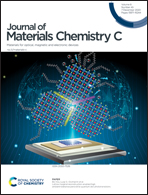Mechanochromic luminescent materials of bimetallic Cu(i) complexes showing thermally activated delayed fluorescence†
Abstract
Mechanochromic luminescence has recently received increasing interest due to its promising applications. Herein we report a new series of ionic bimetallic Cu(I) complexes exhibiting reversible mechanochromic luminescence and thermally activated delayed fluorescence. These Cu(I) complexes possess one emissive [{Cu(N^N)}2(μ-dppm)2]2+ cation with two N–H groups in two functional 3-(2′-pyridyl)pyrazole (N^N) ligands, and each N–H proton forms a N–H⋯O hydrogen bond with one O atom of a counterion ClO4−. It is shown that reversible mechanochromic luminescence is relevant to the breaking and restoring of the NH⋯O hydrogen bonds controlled by mechanical grinding and CH2Cl2 vapor, which is well supported by their FT-IR analyses. Importantly, the difference of those two inter-convertible luminous colors appearing in luminescence mechanochromism can be effectively regulated by altering the electronic nature of the substituent on the pyrazole ring such as the trifluoromethyl and tert-butyl. This clearly suggests that rationally designed Cu(I) luminescent complexes can become promising candidates for developing low-cost intelligent responsive luminescence materials.



 Please wait while we load your content...
Please wait while we load your content...